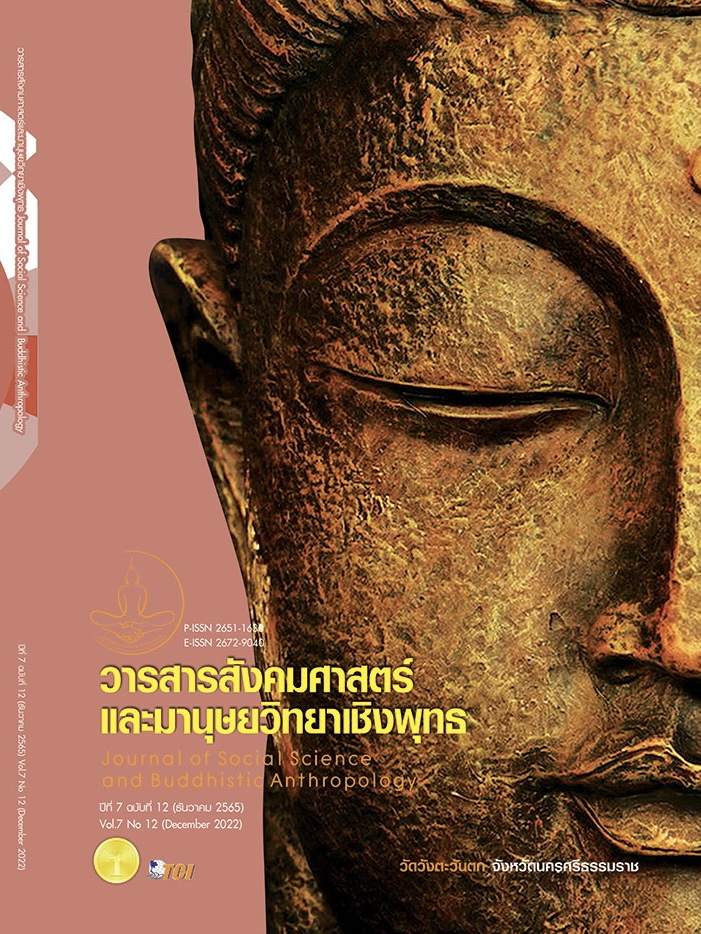GUIDELINES FOR BATIK PRODUCT DEVELOPMENT APPLYING COATING AND FRAGRANCE DECORATION TECHNIQUES FOR NONTHABURI PROVINCE ARTS AND CRAFTS COOPERATIVE GROUP
Keywords:
Batik Fabric, Fabric Fragrance Decoration, Microcapsule, Stabilizer Coating, Product DevelopmentAbstract
The objectives of this research article were to explore the effect of batik fabric coating with the most suitable product stabilizer to be applied to the fabric souvenir products. After the application of microcapsules and fragrance decoration, the satisfaction and the transfer of batik product stabilizer coating techniques and fragrance decoration techniques were assessed. The study applied a mixed research methodology using a quasi - experimental research process to study the stabilizing and decorative properties of the batik fabric. The quantitative research approach was applied to assess the target group’s satisfaction with the transfer of batik products. The study results revealed that the powder gelatin stabilizer was the most suitable stabilizer for the fabric. The mixture ratio of powder gelatin was 15 grams per 3,300 ml. of clean water. The fabric coated with the powder gelatin stabilizer was tested for fabric hardness using the stiffness tester. The bending length of the warp yarn was measured, gaining an average of 4.78 cm and 4.92 cm. for the weft yarn. The fabrics coated with the powder gelatin stabilizer demonstrated the highest amount of microcapsule adhesion. It was found that the powder gelatin stabilizer had provided gelling agents during fabric stability and suitable fragrance decoration. The target group revealed the highest level of satisfaction at an average of 4.93 on the application of the batik fabric product coating and fragrance decoration techniques which could be transferred as guidelines for the product development of the community product manufacturers
References
ณิชาภัทร สมบูรณ์. (2556). สมบัติของเจลผสมระหว่างวุ้นกับเจลาตินปลา. ใน วิทยานิพนธ์วิทยาศาสตรมหาบัณฑิต สาขาวิชาวิทยาศาสตร์การอาหารและโภชนาการ. มหาวิทยาลัยสงขลานครินทร์.
ณุกานดา ภัทรปุตรานนท์ และคณะ. (2558). สมบัติทางกายภาพของผ้าฝ้ายผสมแสปนเด็กส์ตกแต่งด้วยไมโครแคปซูลกลิ่นน้ำมันหอมระเหย. ใน เอกสารการประชุมใหญ่วิชาการระดับชาติ ครั้งที่ 6. มหาวิทยาลัยหาดใหญ่.
เทวี ทองแดง คาร์ริลา. (2557). สารก่อเจลสำหรับอาหารฮาลาล: สารผสมระหว่างเจลาตินปลาและวุ้น. ใน รายงานการวิจัย. มหาวิทยาลัยสงขลานครินทร์.
นงลักษณ์ สุธาพจน์. (2554). การพัฒนาชุดเครื่องนอนเคลือบกลิ่นหอมด้วยเทคโนโลยีไมโครเอนแคปซูเลชัน. ใน วิทยานิพนธ์คหกรรมศาสตรมหาบัณฑิต สาขาวิชาเทคโนโลยีคหกรรมศาสตร์. มหาวิทยาลัยเทคโนโลยีราชมงคลธัญบุรี.
พิมพ์เพ็ญ พรเฉลิมพงศ์. (2561). สารที่ทำให้คงตัว. เรียกใช้เมื่อ 24 กันยายน 2561 จาก www.foodnetworksolution.com/wiki/word/1466/stabilizing - agent - สารที่ทำให้คงตัว
ภาวดี อังค์วัฒนะ. (2563). นาโนเทค - สวทช. เปิดโรงงานต้นแบบสิ่งทอ พร้อมให้บริการเคลือบสิ่งทอได้มากถึง 5 สมบัติในขั้นตอนเดียว. เรียกใช้เมื่อ 24 กรกฎาคม 2563 จาก https://m.mgronline.com/science/detail/9630000036549
ลัดดา วันยาเล. (16 มีนาคม 2560). ความต้องการที่จะกระตุ้นยอดขายผ้าบาติก. (รุ่งฤทัย รำพึงจิต, ผู้สัมภาษณ์)
สำนักงานส่งเสริมเศรษฐกิจสร้างสรรค์. (2564). จากการให้และรับสู่การสร้างระบบเศรษฐกิจ. เรียกใช้เมื่อ 26 มกราคม 2565 จาก https://www.cea.or.th/th/single - statistic/gift - economy
สุรีย์ เข็มทอง. (2555). ธุรกิจสินค้าที่ระลึก. ใน รายงานการวิจัย. มหาวิทยาลัยสุโขทัยธรรมาธิราช.
อริณ เมืองสมบัติ และหควณ ชูเพ็ญ. (2554). ความสำเร็จในการบริหารจัดการอาชีพกลุ่มอาชีพทำผ้าบาติกเทศบาลตำบลหนองจอก. วารสารการบริหารท้องถิ่น, 4(2), 30 - 42.
อ้อมบุญ วัลลิสุต. (2557). อโรมาเธอราพี. เรียกใช้เมื่อ 24 กันยายน 2561 จาก https://pharmacy.mahidol.ac.th/th/knowledge/article/225/อโรมาเธอราพี(Aromatherapy)
Downloads
Published
How to Cite
Issue
Section
License

This work is licensed under a Creative Commons Attribution-NonCommercial-NoDerivatives 4.0 International License.








